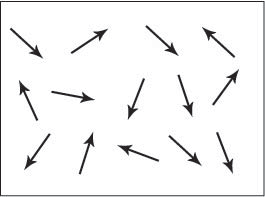Types of Magnetism
Before discussing the different types of magnetism we need clear up a few definitions which are used to categorise the types of magnetism.
Magnetic Suseptibily
As the magnetic field increases, the magnetic flux increases. We denote magnetic field intensity by H and magnetic flux by B the constant of proportionality is μ0 this is known as the magnetic permitivity
In a vacuum, μ0 has a value of 4π x 10-7 H m-1 in SI units
For other materials this proportionality is expressed with the relative permitivity, μr
The susceptibility χ is defined in terms of the relative permitivity. χ = (μr - 1)
Ferromagnetism
 alignment of electron spins
alignment of electron spinsAnti-Ferromagnetism
Ferrimagnetism

Diamagnetism
Diamagnetic materials are composed of atoms that have no net magnetic moments. However, when exposed to a field a weak negative magnetisation is produced which causes repulsion instead of attraction. Diamagnetic materials have negative susceptibilty with magnetitude of around -10
Many common materials are diamagnetic and hence In the presence of very strong magentic fields the repulsion caused by diamagnetism can cause objects to levitate even frogs.

Paramagnetism
Paramagnetic materials such as liquid oxygen and aluminium show a weak magnetic attraction when placed near a magnet. Some atoms or ions in the material have a net magentic moment due to unpaired electrons in partially filled orbitals. In the presence of a field, there is a partial alignment of the atomic magnetic moments in the direction of the field resulting in a net positive magnetisation and positive susceptibility.
In a strong magnetic field, paramagnetic materials become magentic and will stay magnetic while the field is present. When the strong magnetic field is removed the net magnetic alignment is lost and the magnetic dipoles relax to a random motion.
No comments:
Post a Comment